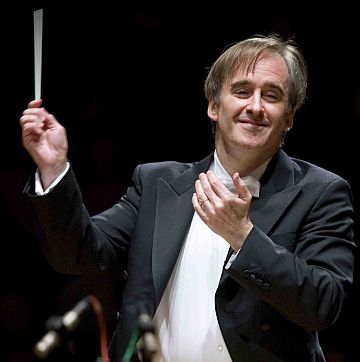Conlon, New World make powerful case for neglected Shostakovich symphony

James Conlon conducted the New World Symphony in music of Beethoven and Shostakovich Saturday night.
The conductor James Conlon stepped onto the podium at New World Center in Miami Beach to make a sales pitch for what he called “an unjustly neglected symphony.”
Conlon, music director of the Los Angeles Opera, was about to lead the New World Symphony in Shostakovich’s Symphony No. 12, subtitled “The Year 1917.” The 1961 work is often considered the composer’s weakest symphony, its poor reputation stemming partly from its submission to the demands of Soviet propaganda.
The symphony is dedicated to Lenin and celebrates the Bolshevik Revolution. The last movement, in which the Bolsheviks are victorious and thus able to initiate a reign that would eventually bring their country Stalin, the Gulag and the KGB, carries the ridiculous title, “The Dawn of Humanity.” And around the time of the symphony’s composition, after holding out for years, Shostakovich finally joined the Communist Party.
While such circumstances have led many to dismiss the symphony as totalitarian propaganda on a par with paintings of heroic operators of wheat threshers, they would be wrong. As Conlon stated, and then demonstrated in Saturday’s performance, this is an exciting, original symphony, with brilliant orchestration and high drama, a work that creates edge-of-the-seat suspense at it unfolds.
From the stark opening–a bold theme in cellos and basses followed by ominous rumblings through the orchestra–the first movement generates an air of expectation, presumably as revolutionary forces gather in St. Petersburg. The payoff comes quickly, in climactic, fortissimo passages for winds and brass, with brilliant flute and piccolo playing, over surging, frantic strings. These grim, hard-driving passages are battle music, violent and heroic, and Conlon drew tremendous excitement from the frenzy of sounds.
In the second movement, wind solos rise and fall over rustling strings. There’s a tremendous trombone solo at the end, noble and dark, that’s one of the symphony’s most memorable passages. The symphony required six percussionists, counting the timpani, and all were busy in the third movement, with crackling attacks on multiple drums and other percussion that created a relentless, military tone, along with the baleful shrieks of winds and brass.
The last movement has been the most mocked for its apparent celebration of the Soviet Union, with a bombastic ending that recalls the ending of the Fifth Symphony. Even if the ending doesn’t quite come off as the affirmative statement it was intended to be, it was still memorable and carried considerable force.
The performance received an ovation, one that was immediate and spontaneous, as opposed to the routine standing ovations that have become standard for most South Florida concerts. Many members of the audience might have been wondering why it’s taken them this long to encounter such an exciting, effective piece of music. It may be best to forget the symphony’s ostensible subject, or any of the ways in which Shostakovich might have been turning it back on his communist oppressors, and take the symphony for what it is—a brilliant concert work by a master composer.
The concert opened with Beethoven’s Symphony No. 2. If not exactly neglected like the Shostakovich, the Second is heard less frequently than several of the composer’s other symphonies. Written before the breakthrough of his Symphony No. 3, it’s full of melody and drama, as the maturing composer’s genius presses against the form he inherited from Haydn.
If textures felt a bit heavy for a work still rooted in the Classical period, the skill of the musicians showed in their crisp attacks and tight ensemble work. The slow opening unfolded with an air of mystery, expressed with delicacy in winds and strings. The Allegro that followed came off with precision and high spirits. Under Conlon’s direction, the orchestra played in a sharp, responsive manner, with knife-edge attacks after the rests with which Beethoven punctuates the music, with a powerful, trumpet-topped climax at the end.
In the second movement, the wind section played with particularly sensitive phrasing and refinement. Passages for bassoon, joined at times by clarinet and oboe, were foreboding and tonally rich, in characteristic combinations of instruments that Beethoven would make much more use of in later works. Although the Scherzo is intended to be a bumpy ride, the dynamics felt exaggerated in this performance, with fortissimos that stretched the work far out of its Classical proportions. In the last movement, the orchestra played with Classical grace and a touch of Beethovenian humor, without overdoing it.
Before the concert, the New World Symphony inserted itself into the debate over President Trump’s proposed budget, projecting a statement on a screen over the stage denouncing the planned elimination of the National Endowment for the Arts.
“The New World Symphony strongly believes in public funding for the arts,” the statement read in part, generating applause and scattered cheers. “We encourage those who agree to contact your Senators and Representatives to voice your support for the NEA.”
The New World Symphony will repeat the program 2 p.m. Sunday at New World Center in Miami Beach. nws.edu; 305-673-3331
Posted in Performances
Leave a Comment
Sun Mar 26, 2017
at 11:46 am
No Comments